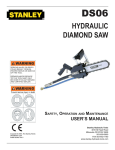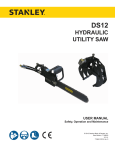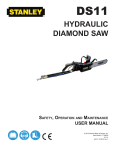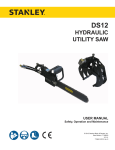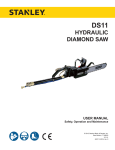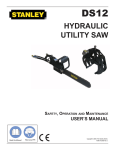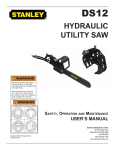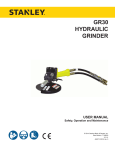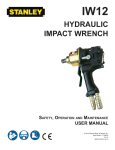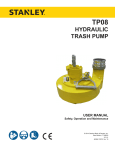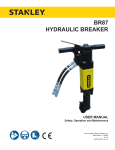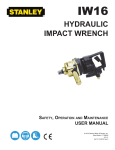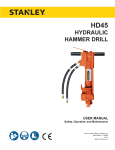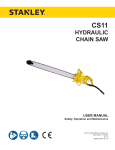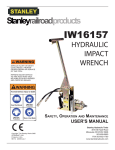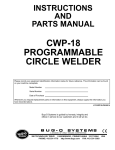Download DS06 User Manual - Stanley Hydraulic Tools
Transcript
DS06 HYDRAULIC DIAMOND SAW USER MANUAL Safety, Operation and Maintenance © 2014 Stanley Black & Decker, Inc. New Britain, CT 06053 U.S.A. 34566 2/2015 Ver. 10 DECLARATION OF CONFORMITY DECLARATION OF CONFORMITY ÜBEREINSTIMMUNGS-ERKLARUNG DECLARATION DE CONFORMITE CEE DECLARACION DE CONFORMIDAD DICHIARAZIONE DI CONFORMITA Hydraulic Tools ______________________________________________________________________ I, the undersigned: Ich, der Unterzeichnende: Je soussigné: El abajo firmante: lo sottoscritto: Weisbeck, Andy Surname and First names/Familiennname und Vornamen/Nom et prénom/Nombre y apellido/Cognome e nome hereby declare that the equipment specified hereunder: bestätige hiermit, daß erklaren Produkt genannten Werk oder Gerät: déclare que l’équipement visé ci-dessous: Por la presente declaro que el equipo se especifica a continuación: Dichiaro che le apparecchiature specificate di seguito: Concrete Cutting Chainsaw, Hydraulic 1. Category: Kategorie: Catégorie: Categoria: Categoria: 2. Make/Marke/Marque/Marca/Marca 3. Type/Typ/Type/Tipo/Tipo: 4. Serial number of equipment: Seriennummer des Geräts: Numéro de série de l’équipement: Numero de serie del equipo: Matricola dell´attrezzatura: Stanley DS06200001, DS06300001 All Has been manufactured in conformity with Wurde hergestellt in Übereinstimmung mit Est fabriqué conformément Ha sido fabricado de acuerdo con E’ stata costruita in conformitá con Directive/Standards Richtlinie/Standards Directives/Normes Directriz/Los Normas Direttiva/Norme No. Nr Numéro No n. Approved body Prüfung durch Organisme agréé Aprobado Collaudato EN ISO 12100:2010 Self EN ISO ISO ISO Machinery Directive 3744:2010 20643:2005 10726:1992 2006/42/EC:2006 Self Self Self Self 5. Special Provisions: None Spezielle Bestimmungen: Dispositions particulières: Provisiones especiales: Disposizioni speciali: 6. Representative in the Union: Patrick Vervier, Stanley Dubuis 17-19, rue Jules Berthonneau-BP 3406 41034 Blois Cedex, France. Vertreter in der Union/Représentant dans l’union/Representante en la Union/Rappresentante presso l’Unione Done at/Ort/Fait à/Dado en/Fatto a Stanley Hydraulic Tools, Milwaukie, Oregon USA Signature/Unterschrift/Signature/Firma/Firma Position/Position/Fonction/Cargo/Posizione 2 ► DS06 User Manual Director of Product Development Date/Datum/le/Fecha/Data 1-4-11 TABLE OF CONTENTS DECLARATION OF CONFORMITY...........................................................................................................................2 SAFETY SYMBOLS...................................................................................................................................................4 SAFETY PRECAUTIONS...........................................................................................................................................5 TOOL STICKERS & TAGS.........................................................................................................................................7 HOSE TYPES.............................................................................................................................................................8 HOSE RECOMMENDATIONS...................................................................................................................................9 HTMA REQUIREMENTS..........................................................................................................................................10 OPERATION............................................................................................................................................................. 11 MAINTENANCE & ADJUSTMENTS.........................................................................................................................14 TOOL PROTECTION & CARE.................................................................................................................................19 TROUBLESHOOTING.............................................................................................................................................20 DIAMOND CHAIN APPLICATIONS..........................................................................................................................21 SPECIFICATIONS....................................................................................................................................................22 ACCESSORIES.......................................................................................................................................................22 DS06 PARTS ILLUSTRATION.................................................................................................................................23 DS06 PARTS LIST...................................................................................................................................................24 IMPORTANT To fill out a Product Warranty Validation form, and for information on your warranty, visit Stanleyhydraulics.com and select the Company tab, Warranty. (NOTE: The warranty Validation record must be submitted to validate the warranty). SERVICING: This manual contains safety, operation, and routine maintenance instructions. Stanley Hydraulic Tools recommends that servicing of hydraulic tools, other than routine maintenance, must be performed by an authorized and certified dealer. Please read the following warning. WARNING SERIOUS INJURY OR DEATH COULD RESULT FROM THE IMPROPER REPAIR OR SERVICE OF THIS TOOL. REPAIRS AND / OR SERVICE TO THIS TOOL MUST ONLY BE DONE BY AN AUTHORIZED AND CERTIFIED DEALER. For the nearest authorized and certified dealer, call Stanley Hydraulic Tools at the number listed on the back of this manual and ask for a Customer Service Representative. DS06 User Manual ◄ 3 SAFETY SYMBOLS Safety symbols and signal words, as shown below, are used to emphasize all operator, maintenance and repair actions which, if not strictly followed, could result in a life-threatening situation, bodily injury or damage to equipment. This is the safety alert symbol. It is used to alert you to potential personal injury hazards. Obey all safety messages that follow this symbol to avoid possible injury or death. DANGER This safety alert and signal word indicate an imminently hazardous situation which, if not avoided, will result in death or serious injury. WARNING This safety alert and signal word indicate a potentially hazardous situation which, if not avoided, could result in death or serious injury. CAUTION This safety alert and signal word indicate a potentially hazardous situation which, if not avoided, could result in death or serious injury. CAUTION This signal word indicates a potentially hazardous situation which, if not avoided, may result in property damage. NOTICE This signal word indicates a situation which, if not avoided, will result in damage to the equipment. IMPORTANT This signal word indicates a situation which, if not avoided, may result in damage to the equipment. Always observe safety symbols. They are included for your safety and for the protection of the tool. LOCAL SAFETY REGULATIONS Enter any local safety regulations here. Keep these instructions in an area accessible to the operator and maintenance personnel. 4 ► DS06 User Manual SAFETY PRECAUTIONS Tool operators and maintenance personnel must always comply with the safety precautions given in this manual and on the stickers and tags attached to the tool and hose. • Do not rely exclusively upon the safety devices built into the chain saw. As a chain saw user, several steps must be taken to keep your cutting jobs free from accident or injury: These safety precautions are given for your safety. Review them carefully before operating the tool and before performing general maintenance or repairs. a. With a basic understanding of kickbacks, you can reduce or eliminate the element of surprise. Sudden surprise contributes to accidents. Supervising personnel should develop additional precautions relating to the specific work area and local safety regulations. If so, place the added precautions in the space provided in this manual. b. Keep a good firm grip on the chain saw with both hands, the right hand on the rear handle and the left hand on the front handle when operating the chain saw. Use a firm grip with thumbs and fingers encircling the chain saw handles. A firm grip helps reduce kickbacks and maintains control of the chain saw. Do not let go. The DS06 Diamond Saw will provide safe and dependable service if operated in accordance with the instructions given in this manual. Read and understand this manual and any stickers and tags attached to the tool and hoses before operation. Failure to do so could result in personal injury or equipment damage. c. Make sure the area in which you are cutting is free of obstructions. d. Cut at rated operating speeds (gpm). e. Do not overreach or cut above shoulder height. f. Only use replacement bars and chains specified by Stanley or the equivalent. • Make sure the chain guard is in place before operating the chain saw. • Remove or control the water slurry to prevent yourself or others from slipping while cutting. • Provide adequate ventilation in closed areas when operating a gas or diesel hydraulic power source. • Establish a training program for all operators to ensure safe operation. • The operator must be familiar with all prohibited work areas such as excessive slopes and dangerous terrain conditions. • Do not operate the chain saw unless thoroughly trained or under the supervision of an instructor. • Do not operate a hydraulic power source or a hydraulic diamond saw in an explosive atmosphere. • Always wear safety equipment such as goggles, ear, breathing, head protection, leg protection, gloves, snug fitting clothing and safety shoes at all times when operating the chain saw. • • Do not overreach. Maintain proper footing and balance at all times. • Do not inspect or clean the chain saw while the hydraulic power source is connected. Accidental engagement of the chain saw can cause serious injury. • Always connect hoses to the chain saw hose couplers before energizing the hydraulic power source. Make sure all hose connections are tight. Warning: Use of this tool on certain materials during demolition could generate dust potentially containing a variety of hazardous substances such as asbestos, silica or lead. Inhalation of dust containing these or other hazardous substances could result in serious injury, cancer or death. Protect yourself and those around you. Research and understand the materials you are cutting. Follow correct safety procedures and comply with all applicable national, state or provisional health and safety regulations relating to them, including, if appropriate arranging for the safe disposal of the materials by a qualified person. • Do not operate the chain saw at fluid temperatures above 140 °F/60 °C. Operation at higher temperatures can cause higher than normal temperatures at the chain saw which can result in operator discomfort. • DS06 User Manual ◄ 5 SAFETY PRECAUTIONS • Always be well rested and mentally alert before operating the chain saw. • Check all chain breaker and rivet spinner components regularly for wear and general condition. • Do not allow bystanders near the chain saw when starting or cutting. • Avoid contact with the saw bar rails as they can become very sharp during use. • Do not start cutting until you have a clear work area and secure footing. • Provide adequate lighting when operating the saw in a darkened area or at night. • Keep all parts of the body away from the chain saw during operation, including loose clothing and long hair. • Always keep critical tool markings, such as labels and warning stickers legible. Always replace stickers and decals that have become worn or damaged. • Carry the chain saw with the tool de-energized and the bar and chain to the rear of your body. • • Do not operate a chain saw that is damaged, improperly adjusted, or not completely and securely assembled. Make sure the chain stops moving when the control trigger is released. Be observant of hydraulic and water hoses that lay about the work area, especially in trenches where they can be hidden from view due to liquids that have accumulated within the space. • Keep all parts of the body away from the cleats that are attached to the saw, as these are sharp and can be a puncture hazard. • Improper handling, use, or maintenance can result in an oil leak or burst. Do not contact an oil leak as high pressure oil can cause injection into the body. • Never stand in the path of the discharge, as ejection of material from the work piece can cause personal injury. • Never use the saw in a potentially explosive atmosphere. • WARNING: Hydraulic fluid under pressure could cause skin injection injury. If you are injured by hydraulic fluid, get medical attention immediately. • Keep the handle dry, clean and free of hydraulic fluid. • Do not use the chain saw near energized transmission lines. • Turn off the power source or move the hydraulic control valve to neutral before setting the chain saw down. • Use a guide bar scabbard when transporting the chain saw. • Know the location of buried or covered utilities before starting work. • To avoid personal injury or equipment damage, all chain saw repair, maintenance and service must only be performed by authorized and properly trained personnel. • Make sure the chain breaker and rivet spinner are securely mounted on flat, clean work surfaces. Check the mounting screws/bolts often. 6 ► DS06 User Manual TOOL STICKERS & TAGS Lwa 28323 CE Decal 11212 Sound Level Decal 11206 Circuit C Decal (5-GPM Models) 11207 Circuit D Decal (8-GPM models) 73659 Name Tag Decal CAUTION DANGER 7-9 GPM / 26-34 LPM DO NOT EXCEED 2000 PSI / 140 BAR Failure to use hydraulic hose labeled and certified as non-conductive when using hydraulic tools on DO NOT EXCEED SPECIFIED FLOW OR PRESSURE USE CLOSED-CENTER TOOL ON CLOSED-CENTER SYSTEM. USE OPEN-CENTER TOOL ON OPEN-CENTER SYSTEM. CORRECTLY CONNECT HOSES TO TOOL “IN” AND “OUT” PORTS. IMPROPER HANDLING, USE OR OTHER MAINTENANCE OF TOOL COULD RESULT IN A LEAK, BURST OR OTHER TOOL FAILURE. CONTACT AT A LEAK OR BURST CAN CAUSE OIL INJECTION INTO THE BODY. FAILURE TO OBSERVE THESE PRECAUTIONS CAN RESULT IN SERIOUS PERSONAL INJURY. or near electric lines may result in death or serious injury. For proper and safe operation read owners manual and mwke sure that you have been properly ELECTROCUTION HAZARD trained in correct procedures required for work on or around electric lines. 12412 Warning Sticker–Electrical 28409 Composite Decal 03786 GPM sticker, 7–9 2000 psi DS063000 only NOTE: THE INFORMATION LISTED ON THE STICKERS SHOWN, MUST BE LEGIBLE AT ALL TIMES. REPLACE DECALS IF THEY BECOME WORN OR DAMAGED. REPLACEMENTS ARE AVAILABLE FROM YOUR LOCAL STANLEY DISTRIBUTOR. The safety tag (P/N 15875) at right is attached to the tool when shipped from the factory. Read and understand the safety instructions listed on this tag before removal. We suggest you retain this tag and attach it to the tool when not in use. D A N G E R 1. FAILURE TO USE HYDRAULIC HOSE LABELED AND CERTIFIED AS NON-CONDUCTIVE WHEN USING HYDRAULIC TOOLS ON OR NEAR ELECTRICAL LINES MAY RESULT IN DEATH OR SERIOUS INJURY. BEFORE USING HOSE LABELED AND CERTIFIED AS NONCONDUCTIVE ON OR NEAR ELECTRIC LINES BE SURE THE HOSE IS MAINTAINED AS NON-CONDUCTIVE. THE HOSE SHOULD BE REGULARLY TESTED FOR ELECTRIC CURRENT LEAKAGE IN ACCORDANCE WITH YOUR SAFETY DEPARTMENT INSTRUCTIONS. 2. A HYDRAULIC LEAK OR BURST MAY CAUSE OIL INJECTION INTO THE BODY OR CAUSE OTHER SEVERE PERSONAL INJURY. A. DO NOT EXCEED SPECIFIED FLOW AND PRESSURE FOR THIS TOOL. EXCESS FLOW OR PRESSURE MAY CAUSE A LEAK OR BURST. B. DO NOT EXCEED RATED WORKING PRESSURE OF HYDRAULIC HOSE USED WITH THIS TOOL. EXCESS PRESSURE MAY CAUSE A LEAK OR BURST. C. CHECK TOOL HOSE COUPLERS AND CONNECTORS DAILY FOR LEAKS. DO NOT FEEL FOR LEAKS WITH YOUR HANDS. CONTACT WITH A LEAK MAY RESULT IN SEVERE PERSONAL INJURY. D A N G E R D. DO NOT LIFT OR CARRY TOOL BY THE HOSES. DO NOT ABUSE HOSE. DO NOT USE KINKED, TORN OR DAMAGED HOSE. 3. MAKE SURE HYDRAULIC HOSES ARE PROPERLY CONNECTED TO THE TOOL BEFORE PRESSURING SYSTEM. SYSTEM PRESSURE HOSE MUST ALWAYS BE CONNECTED TO TOOL “IN” PORT. SYSTEM RETURN HOSE MUST ALWAYS BE CONNECTED TO TOOL “OUT” PORT. REVERSING CONNECTIONS MAY CAUSE REVERSE TOOL OPERATION WHICH CAN RESULT IN SEVERE PERSONAL INJURY. 4. DO NOT CONNECT OPEN-CENTER TOOLS TO CLOSEDCENTER HYDRAULIC SYSTEMS. THIS MAY RESULT IN LOSS OF OTHER HYDRAULIC FUNCTIONS POWERED BY THE SAME SYSTEM AND/OR SEVERE PERSONAL INJURY. 5. BYSTANDERS MAY BE INJURED IN YOUR WORK AREA. KEEP BYSTANDERS CLEAR OF YOUR WORK AREA. 6. WEAR HEARING, EYE, FOOT, HAND AND HEAD PROTECTION. 7. TO AVOID PERSONAL INJURY OR EQUIPMENT DAMAGE, ALL TOOL REPAIR MAINTENANCE AND SERVICE MUST ONLY BE PERFORMED BY AUTHORIZED AND PROPERLY TRAINED PERSONNEL. I M P O R T A N T I M P O R T A N T READ OPERATION MANUAL AND SAFETY INSTRUCTIONS FOR THIS TOOL BEFORE USING IT. READ OPERATION MANUAL AND SAFETY INSTRUCTIONS FOR THIS TOOL BEFORE USING IT. USE ONLY PARTS AND REPAIR PROCEDURES APPROVED BY STANLEY AND DESCRIBED IN THE OPERATION MANUAL. USE ONLY PARTS AND REPAIR PROCEDURES APPROVED BY STANLEY AND DESCRIBED IN THE OPERATION MANUAL. TAG TO BE REMOVED ONLY BY TOOL OPERATOR. TAG TO BE REMOVED ONLY BY TOOL OPERATOR. SEE OTHER SIDE SEE OTHER SIDE SAFETY TAG P/N 15875 (Shown smaller then actual size) DS06 User Manual ◄ 7 HOSE TYPES The rated working pressure of the hydraulic hose must be equal to or higher than the relief valve setting on the hydraulic system. There are three types of hydraulic hose that meet this requirement and are authorized for use with Stanley Hydraulic Tools. They are: Certified non-conductive — constructed of thermoplastic or synthetic rubber inner tube, synthetic fiber braid reinforcement, and weather resistant thermoplastic or synthetic rubber cover. Hose labeled certified nonconductive is the only hose authorized for use near electrical conductors. Wire-braided (conductive) — constructed of synthetic rubber inner tube, single or double wire braid reinforcement, and weather resistant synthetic rubber cover. This hose is conductive and must never be used near electrical conductors. Fabric-braided (not certified or labeled non-conductive) — constructed of thermoplastic or synthetic rubber inner tube, synthetic fiber braid reinforcement, and weather resistant thermoplastic or synthetic rubber cover. This hose is not certified non-conductive and must never be used near electrical conductors. HOSE SAFETY TAGS To help ensure your safety, the following DANGER tags are attached to all hose purchased from Stanley Hydraulic Tools. DO NOT REMOVE THESE TAGS. If the information on a tag is illegible because of wear or damage, replace the tag immediately. A new tag may be obtained from your Stanley Distributor. D A N G E R D A N G E R 1. FAILURE TO USE HYDRAULIC HOSE LABELED AND CERTIFIED AS NON-CONDUCTIVE WHEN USING HYDRAULIC TOOLS ON OR NEAR ELECTRIC LINES MAY RESULT IN DEATH OR SERIOUS INJURY. FOR PROPER AND SAFE OPERATION MAKE SURE THAT YOU HAVE BEEN PROPERLY TRAINED IN CORRECT PROCEDURES REQUIRED FOR WORK ON OR AROUND ELECTRIC LINES. 2. BEFORE USING HYDRAULIC HOSE LABELED AND CERTIFIED AS NON-CONDUCTIVE ON OR NEAR ELECTRIC LINES. WIPE THE ENTIRE LENGTH OF THE HOSE AND FITTING WITH A CLEAN DRY ABSORBENT CLOTH TO REMOVE DIRT AND MOISTURE AND TEST HOSE FOR MAXIMUM ALLOWABLE CURRENT LEAKAGE IN ACCORDANCE WITH SAFETY DEPARTMENT INSTRUCTIONS. 3. DO NOT EXCEED HOSE WORKING PRESSURE OR ABUSE HOSE. IMPROPER USE OR HANDLING OF HOSE COULD RESULT IN BURST OR OTHER HOSE FAILURE. KEEP HOSE AS FAR AWAY AS POSSIBLE FROM BODY AND DO NOT PERMIT DIRECT CONTACT DURING USE. CONTACT AT THE BURST CAN CAUSE BODILY INJECTION AND SEVERE PERSONAL INJURY. 4. HANDLE AND ROUTE HOSE CAREFULLY TO AVOID KINKING, ABRASION, CUTTING, OR CONTACT WITH HIGH TEMPERATURE SURFACES. DO NOT USE IF KINKED. DO NOT USE HOSE TO PULL OR LIFT TOOLS, POWER UNITS, ETC. 5. CHECK ENTIRE HOSE FOR CUTS CRACKS LEAKS ABRASIONS, BULGES, OR DAMAGE TO COUPLINGS IF ANY OF THESE CONDITIONS EXIST, REPLACE THE HOSE IMMEDIATELY. NEVER USE TAPE OR ANY DEVICE TO ATTEMPT TO MEND THE HOSE. 6. AFTER EACH USE STORE IN A CLEAN DRY AREA. SEE OTHER SIDE SIDE 1 SEE OTHER SIDE (Shown smaller than actual size) DO NOT REMOVE THIS TAG DO NOT REMOVE THIS TAG THE TAG SHOWN BELOW IS ATTACHED TO “CERTIFIED NON-CONDUCTIVE” HOSE SIDE 2 D A N G E R D A N G E R 1. DO NOT USE THIS HYDRAULIC HOSE ON OR NEAR ELECTRIC LINES. THIS HOSE IS NOT LABELED OR CERTIFIED AS NON-CONDUCTIVE. USING THIS HOSE ON OR NEAR ELECTRICAL LINES MAY RESULT IN DEATH OR SERIOUS INJURY. 5. CHECK ENTIRE HOSE FOR CUTS CRACKS LEAKS ABRASIONS, BULGES, OR DAMAGE TO COUPLINGS IF ANY OF THESE CONDITIONS EXIST, REPLACE THE HOSE IMMEDIATELY. NEVER USE TAPE OR ANY DEVICE TO ATTEMPT TO MEND THE HOSE. 2. FOR PROPER AND SAFE OPERATION MAKE SURE THAT YOU HAVE BEEN PROPERLY TRAINED IN CORRECT PROCEDURES REQUIRED FOR WORK ON OR AROUND ELECTRIC LINES. 6. AFTER EACH USE STORE IN A CLEAN DRY AREA. 3. DO NOT EXCEED HOSE WORKING PRESSURE OR ABUSE HOSE. IMPROPER USE OR HANDLING OF HOSE COULD RESULT IN BURST OR OTHER HOSE FAILURE. KEEP HOSE AS FAR AWAY AS POSSIBLE FROM BODY AND DO NOT PERMIT DIRECT CONTACT DURING USE. CONTACT AT THE BURST CAN CAUSE BODILY INJECTION AND SEVERE PERSONAL INJURY. 4. HANDLE AND ROUTE HOSE CAREFULLY TO AVOID KINKING, CUTTING, OR CONTACT WITH HIGH TEMPERATURE SURFACES. DO NOT USE IF KINKED. DO NOT USE HOSE TO PULL OR LIFT TOOLS, POWER UNITS, ETC. SEE OTHER SIDE SEE OTHER SIDE SIDE 1 SIDE 2 (Shown smaller than actual size) 8 ► DS06 User Manual DO NOT REMOVE THIS TAG DO NOT REMOVE THIS TAG THE TAG SHOWN BELOW IS ATTACHED TO “CONDUCTIVE” HOSE. All hydraulic hose must meet or exceed specifications as set forth by SAE J517. All hydraulic hose must have at least a rated minimum working pressure equal to the maximum hydraulic system relief valve setting. This chart is intended to be used for hydraulic tool applications only based on Stanley Hydraulic Tools tool operating requirements and should not be used for any other applications. The chart to the right shows recommended minimum hose diameters for various hose lengths based on gallons per minute (gpm)/ liters per minute (lpm). These recommendations are intended to keep return line pressure (back pressure) to a minimum acceptable level to ensure maximum tool performance. Tool to Hydraulic Circuit Hose Recommendations 15-34 MM Inside Diameter INCH USE (Press/Return) PSI up to 10 up to 3 3/8 10 Both 2250 49-60 13-16 FLOW >>> RETURN <<< FLOW PRESSURE 26-100 up to 25 100-200 51-100 up to 50 100-300 51-100 up to 50 26-100 up to 25 8-30 up to 8 30-60 15-30 up to 15 30-90 15-30 up to 15 7.5-30 up to 7.5 Figure 1. Typical Hose Connections 49-60 38-49 10-13 13-16 19-40 5-10.5 38-49 19-40 5-10.5 10-13 19-40 5-10.5 38-49 15-23 10-13 15-23 4-6 19 25.4 16 19 19 25.4 5/8 3/4 3/4 1 19 3/4 1 16 3/4 16 19 3/4 5/8 16 5/8 5/8 16 13 13 10 5/8 1/2 1/2 3/8 Return Pressure Return Pressure Return Pressure Return Pressure Both Return Pressure Both Both Both Both 2500 2500 2500 2500 2500 2500 2500 2500 2500 2500 2500 2500 2500 2500 2500 175 175 175 175 175 175 175 175 175 175 175 175 175 175 175 155 BAR Min. Working Pressure Certified Non-Conductive Hose - Fiber Braid - for Utility Bucket Trucks METERS Hose Lengths FEET Conductive Hose - Wire Braid or Fiber Braid -DO NOT USE NEAR ELECTRICAL CONDUCTORS 4-6 4-9 LPM Oil Flow GPM HOSE RECOMMENDATIONS DS06 User Manual ◄ 9 HTMA / EHTMA REQUIREMENTS HTMA / EHTMA REQUIREMENTS HTMA HYDRAULIC SYSTEM REQUIREMENTS TYPE I Nominal Operating Pressure (at the power supply outlet) 4-6 gpm (15-23 lpm) 1500 psi (103 bar) TOOL TYPE TYPE II TYPE RR 7-9 gpm (26-34 lpm) 1500 psi (103 bar) 9-10.5 gpm (34-40 lpm) 1500 psi (103 bar) System relief valve setting (at the power supply outlet) 2100-2250 psi (145-155 bar) 2100-2250 psi (145-155 bar) 2200-2300 psi (152-159 bar) 2100-2250 psi (145-155 bar) Maximum back pressure (at tool end of the return hose) 250 psi (17 bar) 250 psi (17 bar) 250 psi (17 bar) 250 psi (17 bar) Measured at a max. fluid viscosity of: (at min. operating temperature) 400 ssu* 400 ssu* 400 ssu* 400 ssu* (82 centistokes) (82 centistokes) (82 centistokes) (82 centistokes) Temperature: Sufficient heat rejection capacity to limit max. fluid temperature to: (at max. expected ambient temperature) 140° F (60° C) Flow Range 140° F (60° C) 140° F (60° C) TYPE III 11-13 gpm (42-49 lpm) 1500 psi (103 bar) 140° F (60° C) 3 hp 5 hp 6 hp 7 hp Min. cooling capacity at a temperature (2.24 kW) (3.73 kW) (5.22 kW) (4.47 kW) difference of between ambient and fluid 40° F 40° F 40° F 40° F temps (22° C) (22° C) (22° C) (22° C) NOTE: Do not operate the tool at oil temperatures above 140° F (60° C). Operation at higher temperatures can cause operator discomfort at the tool. Filter Min. full-flow filtration Sized for flow of at least: (For cold temp. startup and max. dirt-holding capacity) 25 microns 30 gpm (114 lpm) Hydraulic fluid Petroleum based (premium grade, anti-wear, non-conductive) Viscosity (at min. and max. operating temps) 100-400 ssu* 25 microns 30 gpm (114 lpm) 25 microns 30 gpm (114 lpm) 100-400 ssu* 100-400 ssu* (20-82 centistokes) 25 microns 30 gpm (114 lpm) 100-400 ssu* NOTE: When choosing hydraulic fluid, the expected oil temperature extremes that will be experienced in service determine the most suitable temperature viscosity characteristics. Hydraulic fluids with a viscosity index over 140 will meet the requirements over a wide range of operating temperatures. *SSU = Saybolt Seconds Universal EHTMA HYDRAULIC SYSTEM REQUIREMENTS CLASSIFICATION B C D Nominal Operating Pressure (at the power supply outlet) 3.5-4.3 gpm (13.5-16.5 lpm) 1870 psi (129 bar) 4.7-5.8 gpm (18-22 lpm) 1500 psi (103 bar) 7.1-8.7 gpm (27-33 lpm) 1500 psi (103 bar) 9.5-11.6 gpm (36-44 lpm) 1500 psi (103 bar) 11.8-14.5 gpm (45-55 lpm) 1500 psi (103 bar) System relief valve setting (at the power supply outlet) 2495 psi (172 bar) 2000 psi (138 bar) 2000 psi (138 bar) 2000 psi (138 bar) 2000 psi (138 bar) Flow Range NOTE: These are general hydraulic system requirements. See tool specification page for tool specific requirements 10 ► DS06 User Manual OPERATION PRE-OPERTION PROCEDURES CHECK THE POWER SOURCE 1. Using a calibrated flow meter and pressure gauge, make sure the hydraulic power source develops a flow of 7–9 gpm/26–34 lpm for the 8 gpm model and 4–6 gpm/15–23 lpm for the 5 gpm model at 2000 psi/140 bar. 2. Make certain that the power source is equipped with a relief valve set to open at 2100–2250 psi/145–155 bar. 3. Check that the hydraulic circuit matches the tool for open-center (OC) or closed-center (CC) operation. The DS06 is designed for open-center operation only. CHECK TOOL 1. Make sure all tool accessories are correctly installed. Failure to install tool accessories properly can result in damage to the tool or personal injury. 2. There should be no signs of leaks. 3. The tool should be clean, with all fittings and fasteners tight. 4. Observe the arrow on the couplers to ensure that the hydraulic oil flow is in the proper direction. The female coupler is the inlet (pressure) coupler. 5. Check that the trigger operates smoothly and is free to travel between the ON and OFF positions. 6. Check that the chain is properly installed. The chain is designed to only operate in one direction. Make sure the chain is installed so the bumper guard precedes each diamond segment. See Figure 2. Segment Bumper Guard CORRECT CONNECT HYDRAULIC HOSES 1. Wipe all hose couplers with a clean lint-free cloth before making connections. If necessary, use a light-weight penetrating oil in a spray can to clean the hose couplers before each connection. 2. Connect the hoses from the hydraulic power source to the chain saw fittings or quick disconnects. It is a good practice to connect return hose first and disconnect them last to minimize or avoid trapped pressure within the chain saw. 3. Observe the arrow on the couplers to ensure that the flow is in the proper direction. The female coupler on the chain saw is the inlet (pressure) coupler. NOTE: If uncoupled hoses are left in the sun, pressure increase inside the hoses might make them difficult to connect. Whenever possible, connect the free ends of the hoses together. CONNECTING TO A WATER SUPPLY 1. Using a standard garden hose, connect the DS06 to a city or auxiliary water supply. Make sure the flow is at least 4 gpm/15 lpm at 50 psi/3.5 bar. IMPORTANT Chain and bar damage will occur if the tool operates without the proper water supply and water pressure. 2. Make sure the water is running before starting the tool. 3. If a water pump is being used, refer to the manufacturers instructions for use of the pump. Make sure the pump produces a minimum water flow of 4 gpm/15 lpm at 50 psi/3.5 bar and the water pressure does not exceed 160 psi/11 bar. CHECK CHAIN AND BAR ADJUSTMENT NOTE: Check the chain tension often during operation, especially during the first 1/2 hour when using a new chain. Adjust the chain accordingly when it becomes loose. Follow the procedures contained in the Maintenance and Adjustments section of this manual. INCORRECT Figure 2. Chain Direction 1. Make sure the chain does not exceed a clearance of 5/16 in./8 mm from the bar (see Figure 3). Exceed- DS06 User Manual ◄ 11 OPERATION ing the maximum clearance increases the chance of the chain being dislodged from the bar groove. keep from pinching the saw bar and chain as a result of falling pieces of concrete, brick, etc. 2. Make sure the bar attaching nuts are fully tightened and the chain guard is in place. 2. Make your cuts in the order shown in Figure 5, starting with cut 1 (base horizontal cut) and proceeding with the remaining three cuts. Bottom of Bar Max 5/16" Figure 3. Maximum Chain Clearance CHECK CHAIN SEGMENT WEAR 1. Using adjustable calipers, measure several chain segments as illustrated in Figure 4. Bottom of Bar Min. 1/16" Figure 4. Chain Segment Wear 2. If the average measurement is less than 1/16inch/1.6 mm, then the chain must be replaced. Refer to your Service Manual for chain replacement procedures. OPERATING PROCEDURES 1. Observe all safety precautions. 2. Turn on the water supply. Water at the tool will be directed to the bar and chain when the trigger on the tool is squeezed ON. 3. Operate the tool for two minutes away from the intended cut and then check the chain tension. New chain will normally stretch during its first usage. It is very important to keep the chain tension adjusted so that it does not exceed 5/16 in./8 mm clearance from the bottom of the bar. See Check Chain & Bar Adjustment in this manual. 4. If the chain requires adjustment, see Maintenance & Adjustments in this manual. PLAN THE CUT 1. Plan your cuts to prevent injury to yourself and to 12 ► DS06 User Manual Figure 5. Planning Cuts 3. Outline the concrete area with a permanent marker for a visual guide. 4. Know what kind of material and how much reinforcing you are going to cut. TYPES OF CUTS The DS06 can be operated using the types of cuts shown in Figure 6. When making cuts: NOTICE The following are general cutting procedures and techniques. Differences in the terrain and the type of material being cut will make this information more or less valid for particular areas. For advice on specific cutting problems or techniques, consult your local Stanley Representative. He/she can often provide information that will make your work safer and more productive. OPERATION hydraulic fluid at low power source speed. When using the normally recommended fluids, fluid should be at or above 50 °F/10 °C (400 ssu/82 centistokes) before use. DOWN CUT Damage to the hydraulic system or chain saw can result from use with fluid that is too viscous or thick. USING THE WALL WALKER™ The Wall Walker™ lessens operator fatigue and effort during cutting by automatic insertion of the wedge into the cut, thus allowing the operator to apply leverage to the saw. PLUNGE CUT 1. Position the Wall Walker™ in the "autofeed" position by pinning the lever arm at the lowest hole as shown in the illustration. Start cutting with the DS06 until the cut is large enough to allow the tip of the wedge to insert into the cut. With the tip of the wedge in the cut, the operator can easily apply leverage to the saw which will aid the cutting process and lessen operator fatigue and effort. UP CUT Figure 6. Types of Cuts (chain guard removed for clarity) 1. Do not use a cutting force in excess of 45 lbs/20 kg. Excessive force causes the chain to slow down or stall and causes premature wear of the saw bar and chain. After the saw cuts approximately 1 to 2.5 in./25 to 65 mm, withdraw the saw only enough to allow the lever arm and wedge to reposition. After repositioning, continue cutting. 2. The Wall Walker™ can be positioned to the “parked” position by pinning the lever arm at the upper most hole. In this position, the Wall Walker™ is used as a bucking cleat. 2. Always maintain a high chain speed. High chain speeds produce the best results. 3. Always check that plenty of water is being expelled from the bar and chain. When the tool is running, water is directed to the interior of the bar and then out of several holes located along the top and bottom channels on the bar. If these holes become plugged, cutting debris will not be adequately washed away and will result in premature wear of the bar and chain. 4. Avoid aggressive/heavy plunge forces. Aggressive plunge force creates fragmenting of the concrete when the saw bar and chain exits and causes premature bar and chain wear. COLD WEATHER OPERATION If the saw is to be used during cold weather, preheat the Wall Walker™ Lever Arm (Shown in “autofeed position) Figure 7. Wall Walker™ DS06 User Manual ◄ 13 MAINTENAN & ADJUSTMENTS GENERAL MAINTENANCE TIPS CHAIN TENSION ADJUSTMENT Several simple maintenance tasks which, if performed, can keep a chain saw operating at a high level of efficiency. Routine maintenance also keeps replacement costs down on the parts of the chain saw, which occasionally wear out. Correct chain tension is very important throughout the life of the chain. Check the chain tension often during use (when the chain saw is stopped and the saw bar and chain have cooled off). The chain should move easily around the saw bar when pulled by hand. To adjust the chain tension: If any chain saw disassembly is required, refer to the Service Manual. SAW BAR RAIL 1. Turn off the water and power supplies. 2. Loosen the two saw bar attachment nuts (Figure 9). A quick check can be made to determine if saw bar rail or chain segment wear exists. Figure 8 shows a worn saw bar rail. Bar Attachment Nuts (2) Bar Adjusting Screw Figure 9. Attachment Screw Locations 3. Using the saw bar adjustment screw (Item 68, Parts Illustration), tighten the chain until you are still able to rotate it one full revolution by hand (Figure 10). Figure 8. Rail Wear If the saw bar rails are worn, use a flat file and dress each one until it is flat and square with the side of the saw bar (Figure 8). Also make sure the saw bar is perfectly straight. If bows or bends are present in the saw bar, it must be replaced before dressing any rail. ROTATING THE SAW BAR Maximum saw bar life can be achieved by occasionally turning the bar over so the top and bottom bar surfaces wear evenly. Refer to the saw bar disassembly procedures in the Service Manual for further details. 14 ► DS06 User Manual Figure 10. Pulling the Chain 4. Pull the chain around the saw bar to make sure it properly fits the sprocket and saw bar. The chain should be easily pulled. 5. Fully tighten the two saw bar attachment nuts (Figure 9). NOTE: Adjust the chain tension each time the drive link tang hangs fully exposed from the groove at the bottom of the saw bar (Figure 11). MAINTENAN & ADJUSTMENTS Max 5/16" Bottom of Bar Figure 11. Exposed Drive Link Tang SERVICING THE CHAIN The following procedures explain how to break a chain using Stanley’s bench mounted chain breaker (P/N 20858) to remove a worn or damaged segment. 1. Mount the chain breaker flush with the side or front of a flat, clean work surface (Figure 12). Figure 14. Inserting the Chain 3. Position the rivet head you want removed directly under the chain-breaker punch and then pull the handle down far enough to remove the rivet (Figure 15). Do not use excessive force. Figure 12. Chain Breaker Mounting NOTE: The Stanley chain breaker is only designed to remove rivet heads from the connecting links, not from a chain segment. The rivet heads shown in the shaded areas of Figure 13 are the only ones that can be removed. Figure 15. Removing a Rivet Figure 13. Removable Rivet Heads 2. Place the chain (the portion that you want broken) into the slot of the anvil pushing it forward until the bottom connecting link is flush with the far side of the slot (Figure 14). DS06 User Manual ◄ 15 MAINTENAN & ADJUSTMENTS REPLACING THE CHAIN BREAKER PUNCH If the chain breaker punch (P/N 22801) becomes worn or damaged, use the following procedures for replacement. 1. Remove the punch by loosening the set screw (Figure 16). Figure 18. Rivet Spinner Mounting 2. Lay the chain across the plastic chain supports and then rotate the supports so the rivet head is centered between the take-up handle pocket and the spinner anvil (Figure 19). Figure 16. Removing the Punch 2. Insert a new punch into the holder and push it up until it is fully seated (Figure 17). Secure the punch to the chain breaker holder by fully tightening the set screw. Figure 19. Positioning the Chain 3. Turn the take-up handle until the chain is tight against the spinner anvil (Figure 20). Rivet Spinner Crank Take-up Handle Figure 17. Replacing the Punch SPINNING RIVETS The following procedures explain how to spin rivets using Stanley’s bench-mounted rivet spinner (P/N 20857) to assembly the chain. 1. Mount the rivet spinner flush with the side or front of a flat, clean work surface (Figure 18). Figure 20. Securing the Chain 4. Turn the rivet spinner crank a few times to center the rivet hub in the spinner anvil (Figure 21). Rivet Spinner Crank Figure 21. Centering the Rivet Hub 16 ► DS06 User Manual Take-up Handle MAINTENAN & ADJUSTMENTS 5. Apply a few drops of oil to the rivet hub (Figure 22). NOSE SPROCKET DISASSEMBLY AND ASSEMBLY 1. Using the bench mounted chain breaker (see accessories), line up the 1/4 inch hole in the side of the chain breaker anvil with the chain breaker punch. Punch out the six nose sprocket rivets. See Figure 25. Figure 22. Applying the Oil 6. Turn the spinner crank while slowly running the takeup handle inward (approximately one full revolution) until the rivet head is formed (Figure 23). NOTE: The take-up handle provides pressure while the spinner anvil forms the rivet head. Figure 25. Punching Out Nose Sprocket Rivets 2. Insert a straight blade screw driver to spread the bar nose rails just enough to remove the old nose sprocket. Use a rag or paper towel to clean the nose sprocket area. See Figure 26. Figure 23. Forming a Rivet Head Figure 26. Removing Old Nose Sprocket Figure 24. Spinner Oiling Chambers NOTE: The rivet spinner is equipped with oiling chambers and should be maintained periodically with a lightweight oil (Figure 24). DS06 User Manual ◄ 17 MAINTENAN & ADJUSTMENTS 3. Remove the new nose sprocket package's clips and fold back the top portion of the insertion card being careful not to remove or disturb the components. See Figure 27. 6. With the bar and rivets solidly supported on a strong flat steel surface, carefully peen the rivet heads down with the flat end of a hammer. Be careful to only hit the rivet head. Do not hit the bar body; this will pinch the nose sprocket. Rivet heads must completely fill the countersinks in the bar body and be snug and secure while still allowing the sprocket to freely turn. See Figure 29. Figure 27. Preparing New Nose Sprocket 4. With a flat blade screw driver in the bar nose rails, slide the nose sprocket assembly into position aligning the 6 holes in the bar nose with the 6 holes in the nose sprocket assembly without removing the components from the card. See Figure 28. Figure 29. Replacing Rivets 7. Using a flat file, shave the rivet heads to a uniform height that is as close to the bar body as possible. See Figure 30 Figure 28. Installing a New Nose Sprocket 5. Insert 6 nose rivets into the holes and then hold them with your thumb. Remove the screwdriver and slide out the insertion card. NOTE: On used bars the nose rails might tend to spread apart. Use a small clamp if necessary to hold the rails together. 18 ► DS06 User Manual Figure 30. Filing Rivets TOOL PROTECTION & CARE NOTICE In addition to the Safety Precautions found in this manual, observe the following for equipment protection and care. • Make sure all couplers are wiped clean before connection. • Always keep critical tool markings, such as warning stickers and tags legible. • The hydraulic circuit control valve must be in the OFF position when coupling or uncoupling hydraulic tools. Failure to do so may result in damage to the quick couplers and cause overheating of the hydraulic system. • Tool repair should be performed by experienced personnel only. • Make certain that the recommended relief valves are installed in the pressure side of the system. • Do not use the tool for applications for which it was not intended. • Always store the tool in a clean dry space, safe from damage or pilferage. • Make sure the circuit PRESSURE hose (with male quick disconnect) is connected to the IN port. The circuit RETURN hose (with female quick disconnect) is connected to the opposite port. Do not reverse circuit flow. This can cause damage to internal seals. • Always replace hoses, couplings and other parts with replacement parts recommended by Stanley Hydraulic Tools. Supply hoses must have a minimum working pressure rating of 2500 psi/172 bar. • Do not exceed the rated flow (see Specifications) page in this manual for correct flow rate and model number. Rapid failure of the internal seals may result. DS06 User Manual ◄ 19 TROUBLESHOOTING If symptoms of poor performance develop, the following chart can be used as a guide to correct the problem. When diagnosing faults in operation of the tool, always check that the hydraulic power source is supplying the correct hydraulic flow and pressure to the tool as listed in the table. Use a flowmeter known to be accurate. Check the flow with the hydraulic oil temperature at least 80 °F/27 °C. SYMPTOM Tool does not run. CAUSE SOLUTION Hydraulic power source not functioning correctly. Check power source for proper flow and pressure (7–9 gpm 26–34 lpm at 2000 psi/140 bar. Coupler or hoses blocked. Remove obstruction. Mechanical failure. Have tool serviced by authorized dealer. Tool runs backwards. Pressure and return lines incorrectly connected. Correct hose connections. Motor shaft rotates counterclockwise as viewed from the end of the motor shaft. Diamond saw cuts slow. Insufficient fluid flow or too high back pressure or relief valve set too low. Check hydraulic supply. If hydraulic supply is correct, have unit serviced by authorized dealer. Back pressure too high. Should not exceed 250 psi/17 bar at 9 gpm/34 lpm measured at the end of the tools operating hoses. Loss of diamond segment side clearance. Replace chain. Chain segment dulled because of continuous use in hard material or rebar. Redress segmented by cutting in abrasive material (i.e. concrete, building block, etc.). NOTE: This indicates that the wrong chain is being used. Wrong chain for application. Scale down to a lower numbered chain. Wired edged bar rails. Dress rails square. Hydraulic fluid mixed in water supply. Have tool serviced. Segment(s) broken or missing. Repair broken segment or replace chain. Chain installed backwards. Correct chain direction. Loose chain tension. Re-tension the chain. Excessive feed force. Reduce feed force. Will not cut straight. Accumulated saw bar wear and uneven chain segment profile wear. Turn the saw bar over and dress rails square. Replace the saw bar and chain. Loss of power. Drive sprocket slipping on Trantorque® adapter. Adjust and tighten Trantorque® adapter to 17 ft lb/23 Nm. Trigger hard to press. Pressure and return hose reversed. Connect for proper flow direction. Motor shaft must rotate clockwise. Back-pressure too high. Should not exceed 250 psi/17 bar @ 9 gpm/34 lpm measured at the end of the tool’s operating hoses. Excessive vibration and cuts rough. 20 ► DS06 User Manual TROUBLESHOOTING SYMPTOM No water discharge at bar. CAUSE SOLUTION Blocked port(s) in bar. Turn off hydraulic supply. Remove bar and chain and clean bar thoroughly. Blow ports with compressed air. Blocked inlet or outlet. Turn off hydraulic supply. Remove bar and chain. Make sure water supply is on. Press trigger to see if water exits near bar adjustment nut area (a small port). If no water exits, have unit serviced. DIAMOND CHAIN APPLICATIONS MODEL BAR LENGTH P/N CORRECT APPLICATIONS Pinnacle- 13 inch Very hard aggregate concretes (flint, chert, granite, etc). Heavy steel reinforcing, 5/8 inch/16 mm diameter and larger. Medium/ hard aggregate concretes (granite, quartz, river rock, etc). Moderate steel reinforcing (wire mesh 3/8-1/2 inch/10-12 mm diameter). Soft aggregate concrete, concrete block, masonry, “green” concrete, highly abrasive conditions. Ultra- 13 inch Medium/hard aggregate concretes (granite, quartz, river rock, etc). Moderate steel reinforcing (wire mesh 3/8-1/2 inch/10-12 mm diameter). Soft aggregate concrete, concrete block, masonry, “green” concrete, highly abrasive conditions. DS06 User Manual ◄ 21 SPECIFICATIONS Cutting Depths....................................................................................................................................13 inches/33 cm Bar Lengths............................................................................................................................................13 inch/33 cm Chain Type..................................................................................................3/8 inch pitch with 21 diamond segments Maximum Back Pressure...................................................................................................................... 250 psi/17 bar Input Flow Range 5 gpm model............................................................................................................................. 4–6 gpm/15–23 lpm 8 gpm model............................................................................................................................. 7–9 gpm/26–34 lpm Input Pressure................................................................................................................................... 2000 psi/140 bar Weight (without bar)....................................................................................................................................14 lbs/6 kg Length (without bar)........................................................................................................................14.3 inches/36 cm Width....................................................................................................................................................9 inches/23 cm Lubrication/Cooling......................................................................................................Internal Water Channels in Bar Porting....................................................................................................................................................-8 SAE O-ring Connection.........................................................................................................................EHTMA/HTMA Flush Face Hose Whips............................................................................................................................................................ Yes Chain Speed 5 gpm model............................................................................................................................... 4600 fpm/23.4 m/s 8 gpm model............................................................................................................................... 5000 fpm/25.4 m/s SOUND POWER AND VIBRATION DECLARATION Measured A-weighted sound power level, Lwa (ref. 1pW) in decibels Uncertainty, Kwa, in decibels Measured A-weighted sound pressure level, Lpa (ref. 20 µPa) at operator’s position, in decibels Uncertainty, Kpa, in decibels 106.2 dBA 3 dBA 98.2 dBA 3 dBA Values determined according to noise test code given in ISO 15744, using the basic standard ISO 3744 NOTE: The sum of a measured noise emission value and its associated uncertainty represents an upper boundary of the range of values which is likely to occur in measurements. Declared vibration emission value in accordance with EN 12096 Measured vibration emission value: a 6.0 m/sec² Uncertainty: K 2.0 m/sec² Values determined according to ISO 8662-1, ISO 5349-1,2 ACCESSORIES Chain Repair Spinner.........................................................................................................................................20857 Diamond Chain Repair Breaker.........................................................................................................................20858 Diamond Chain Service Kit ................................................................................................(sub P/N 20857 or 20858) Diamond Chain Butterfly Repair Kit....................................................................................................................20859 13 inch Bar, Sprocket Nose................................................................................................................................35037 Ultra-25, Diamond Chain for 13 inch Bar...........................................................................................................56799 Pinnacle-25, Diamond Chain for 13 inch Bar.....................................................................................................56800 Water Flow Meter, 0-7 gpm................................................................................................................................60859 Water Pump, 12 VDC, DC Plug.................................................................................................................. DCP30100 Water Pump, 12 VDC, Battery Clips........................................................................................................... DCP30101 22 ► DS06 User Manual DS06 PARTS ILLUSTRATION 54 DS06 User Manual ◄ 23 DS06 PARTS LIST ITEM PART NO. QTY DESCRIPTION ITEM PART NO. QTY DESCRIPTION 1 00753 8 HSHCS 10-24 UNC × 1-1/4 41 36259 1 STEEL BALL, 3/8" DIA. 2 73659 1 NAME TAG 42 32188 1 SPRING 3 11207 1 CIRCUIT D DECAL (8-GPM MODEL) 43 04052 1 O-RING CIRCUIT C DECAL (5-GPM MODEL) 44 32189 1 SEAL CAP REAR GEAR HOUSING ASSY (INCL ITEMS 5–6, 8-GPM MODEL ONLY) 45 28323 1 CE DECAL 46 — — NO ITEM 47 38898 1 SEAL SPACER 48 09098 1 SPROCKET 49 41765 1 WASHER 50 73658 1 CHAIN GUARD 51 32203 2 NUT 52 20721 1 CORD STOCK, 3/16" DIA. 53 43690 1 MOTOR SHAFT (SEE ITEM #60 FOR SERIAL NO. BREAK) 54 04044 2 NEEDLE ROLLER 55 02688 1 HSHCS 5/16 -18 UNC × 3/4 56 60804 1 O-RING 57 19215 1 SEAL BACK-UP WASHER 58 43689 1 SPROCKET ADAPTER 59 58969 1 WIPER SEAL 60 66299 1 SPIRAL RETAINER RING 61 — — SAW BAR (SEE ACCESSORIES) 62 — — NO ITEM 63 32196 1 FLAP MOUNT 64 33219 1 SPACER 65 32192 1 CHAIN GUIDE PLATE 66 32245 1 STUD (SUPPLIED W/ ITEM 22) 67 58968 2 HSHCS 1/4 -20 UNC × 5/8 68 02687 1 MACHINE SCREW 69 32191 1 STAT-O-SEAL 70 32198 1 BAR ADJUSTMENT NUT 71 33481 1 WALL WALKER CLEVIS PIN 72 — — SPRING (INCL W/ ITEM 74) 73 — — CHAIN (SEE ACCESSORIES) 74 32206 1 WALL WALKER 75 02649 1 HANDLE BAR RETAINER 76 33229 1 HANDLE WELDMENT 77 33260 1 BHCS 1/4 -20 × .625 ZINC 78 33261 1 FENDER WASHER 79 73582 1 HAND GUARD 80 12412 1 ELECTRICAL WARNING DECAL 81 12175 2 WASHER 82 33454 2 HHCS 5/16 -18 × 5/8 ZINC 83 33263 1 HANDLE GRIP 84 — — NO ITEM 11206 4 07652 07834 1 1 REAR GEAR HOUSING ASSY (INCL ITEMS 5–6, 5-GPM MODEL ONLY) 5 00289 2 DOWEL PIN 6 04041 4 BUSHING 7 00020 1 O-RING 8 07612 1 IDLER SHAFT 9 — — NO ITEM 10 32190 1 PIVOT PIN 11 00961 1 PIPE PLUG 12 73583 1 HAND GUARD SPACER 13 04106 2 DRIVE GEAR (8-GPM MODEL ONLY) 07832 2 DRIVE GEAR (5-GPM MODEL ONLY) 14 32207 1 ON/OFF VALVE 15 07626 1 O-RING 16 07609 2 SPRING WASHER 17 34119 1 SPRING 18 04512 1 RETAINING RING, 1/2 EX 19 07625 1 PLUG BUTTON 20 03009 2 ROLL PIN 21 07624 1 ROLL PIN, 3/16 × 1 22 73656 1 VALVE HANDLE ASSY (INCL ITEMS 6, 31, 66) 23 01605 — O-RING (SUPPLIED W/ ITEM 24) 24 01652 2 PIGTAIL HOSE ASSY 25 03973 1 MALE COUPLER 26 03972 1 FEMALE COUPLER 27 33443 1 WATER HOSE ASSY 28 58879 1 TRIGGER 29 07602 1 SPRING 30 34105 1 SAFETY CATCH 31 32197 1 STUD (SUPPLIED W/ ITEM 22) 32 — — NO ITEM 33 00072 1 ROLL PIN 34 07627 1 O-RING 35 00074 1 O-RING 36 33488 1 SELF-LOCKING RETAINING RING 37 05632 1 O-RING 38 58970 1 WATER VALVE SLEEVE 39 01403 1 O-RING 40 33380 1 PIN 24 ► DS06 User Manual DS06 PARTS LIST ITEM PART NO. QTY DESCRIPTION 85 17134 1 NUT, 1/4 -20 HHD LT SST 86 31614 1 SPIROL PIN 87 30635 1 SPIROL PIN, 5/16 × 7/8 88 28409 1 COMPOSITE DECAL (CE) 89 11212 1 SOUND POWER LEVEL DECAL (CE) 90 00173 1 QUAD RING 91 04856 1 RETAINING RING 92 35965 1 BEARING 93 00621 1 O-RING 94 38897 1 SEAL WASHER 95 39070 1 V-RING 96 38700 1 SEAL RING 97 — — NO ITEM 98 07324 1 RETAINING RING 99 37793 1 EXTENSION SPRING ANCHOR 100 41764 1 RETAINING RING 03786 1 GPM DECAL (8-GPM MODELS) (NOT SHOWN) 33360 1 SEAL KIT DS06 User Manual ◄ 25 Stanley Hydraulic Tools 3810 SE Naef Road Milwaukie, Oregon 97267-5698 USA (503) 659-5660 / Fax (503) 652-1780 www.stanleyhydraulics.com


























